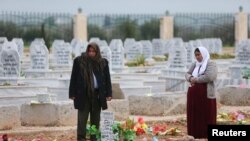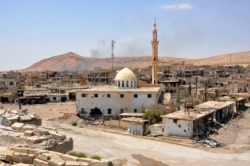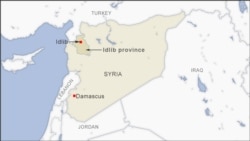Fighters and followers of the Islamic State, undaunted by the collapse of the terror group’s self-declared caliphate in Syria and Iraq, are growing bolder and more dangerous, according to recent assessments by U.S. counterterrorism officials.
The new appraisals attribute the change less to a leap in IS capabilities than to gradual progress due to long-term planning, which has masked the severity of the threat.
“ISIS has been working to rebuild its operational capacity,” a U.S. counterterrorism official told VOA, using another acronym for the terror group. “They’ve made incremental, localized improvements to their operating capacity in primarily eastern Syria over the course of several months.”
And the official, speaking on condition of anonymity, said in many ways, that planning is starting to pay off.
“The group has been more assertive in pockets of Syria in recent weeks as these efforts have progressed, conducting more brazen attacks against Syrian security forces, including regime forces and Syrian Kurdish forces,” the official said.
Attack in Homs province
In one such incident in April, officials said IS forces used a multipronged attack to overrun Syrian regime forces in al-Sukhna, in northern Homs province. IS fighters held parts of the town for more than a day, retreating only after Russian fighter jets launched a sustained counterattack.
“[The attack] signals ISIS’s increased willingness to assume the risk of an overt confrontation against a more capable adversary,” the U.S. official told VOA.
At the same time, counterterrorism officials say IS has ramped up its campaign of intimidation and coercion, exerting a greater degree of control over areas beyond the reach of Syrian government forces, the U.S.-backed Syrian Democratic Forces and the Iraqi government.
And, in areas where those forces are present, top officials have been targeted repeatedly for assassination.
Money, also, does not appear to be a problem for IS.
U.S. officials estimate the terror group still has access to anywhere from $50 million to $300 million in reserves while continuing to rake in profits from extortion, theft, illicit trade and taxes.
Coalition officials more optimistic
The assessment from counterterrorism officials, though, would seem to differ from the more optimistic view shared by coalition military officials, who argue Islamic State is just a shadow of its former self.
“The attacks that we’ve been witnessing here over the past weeks are inconsistent with an organization that we knew of in the past,” Lieutenant General Pat White, the commanding general of Combined Joint Task Force – Operation Inherent Resolve (CJTF-OIR), told reporters this month.
“They are lacking in financing, they are lacking in fighters and they are lacking in support by the populace in most areas,” he added.
Some analysts, however, say there is a problem with the coalition’s rosier assessment, which tends to compare IS’s current capabilities with those it had when it was at its peak.
"We're not talking about a recovery of Islamic State to 2014 levels when they controlled big swaths of Iraq in the second half of the year and when they were a boiling hot insurgency in the first half of the year,” according to Michael Knights, a Boston-based senior fellow of the Washington Institute.
"We're talking about them coming down to something just under 2012 levels, when they were on the upswing and in an early stage of their recovery in Iraq where they were trying to build momentum,” he said. “It's a rural insurgency that lives on peanuts and it's got a lot of infrastructure and inventory, you might say, already in place."
Knights said that infrastructure includes hundreds of caves, tunnels and hidden caches filled with provisions — describing each as an “insurgency in a box” — helping to sustain a continuing surge in attacks.
Lots of fighters
IS also has plenty of fighters at its disposal. The most recent U.S. estimates put the terror group’s force strength in Iraq and Syria at anywhere from 14,000 to 18,000 fighters. And while foreign fighters are not flocking to IS as they did years ago, counterterror officials warn the group’s propaganda has enabled it to continue to recruit.
U.S. counterterrorism officials also worry that other factors are continuing to work in IS’s favor, such as what some describe as the Syrian President Bashar al-Assad’s obsession with retaking Idlib province, which has given IS additional room to manuever.
Officials and analysts also warn IS leaders may be growing more confident that they can wait out the United States, pointing to U.S. troop reductions in Syria and the potential for more troop withdrawals from Iraq.
“The Iraqis seemingly have the will to prosecute counter-IS. But they lack some of the technical capabilities that the coalition contributes and that allow the Iraqis to keep IS insurgents off balance,” said Sam Heller, an analyst who advises the International Crisis Group. "Without this, it seems likely that IS guerrillas will have more space to congregate and mount more involved, complex attacks, and to attempt to penetrate Iraq's more populous urban areas."











